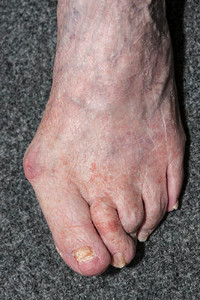Possible Causes of Bunions
Monday, 30 March 2020 00:00 A common sign that you may have developed a bunion is by a bump that gradually forms on the side of the big toe. Additionally, it may appear red, swollen, and can cause severe pain and discomfort. The reasons that a bunion may form can consist of wearing shoes that do not have ample room for the toes to move freely in, or from medical conditions such as arthritis, nerve damage, or due to flat feet. Additionally, genetics may also play a significant role in the development of a bunion, and research has indicated the chances may increase as the aging process occurs. Many patients that have bunions wear custom made orthotics, as this may help relieve a portion of the pressure while wearing shoes. In severe cases, if it becomes difficult to walk, surgery may be a necessary option that can permanently remove the bunion. If you feel you have developed a bunion, it is suggested that you schedule a consultation with a podiatrist who can help choose the best treatment option that is correct for you.
A common sign that you may have developed a bunion is by a bump that gradually forms on the side of the big toe. Additionally, it may appear red, swollen, and can cause severe pain and discomfort. The reasons that a bunion may form can consist of wearing shoes that do not have ample room for the toes to move freely in, or from medical conditions such as arthritis, nerve damage, or due to flat feet. Additionally, genetics may also play a significant role in the development of a bunion, and research has indicated the chances may increase as the aging process occurs. Many patients that have bunions wear custom made orthotics, as this may help relieve a portion of the pressure while wearing shoes. In severe cases, if it becomes difficult to walk, surgery may be a necessary option that can permanently remove the bunion. If you feel you have developed a bunion, it is suggested that you schedule a consultation with a podiatrist who can help choose the best treatment option that is correct for you.
If you are suffering from bunion pain, contact Dr. Mark Spier of Maryland. Our doctor can provide the care you need to keep you pain-free and on your feet.
What Is a Bunion?
Bunions are painful bony bumps that usually develop on the inside of the foot at the joint of the big toe. As the deformity increases over time, it may become painful to walk and wear shoes. Women are more likely to exacerbate existing bunions since they often wear tight, narrow shoes that shift their toes together. Bunion pain can be relieved by wearing wider shoes with enough room for the toes.
Causes
- Genetics – some people inherit feet that are more prone to bunion development
- Inflammatory Conditions - rheumatoid arthritis and polio may cause bunion development
Symptoms
- Redness and inflammation
- Pain and tenderness
- Callus or corns on the bump
- Restricted motion in the big toe
In order to diagnose your bunion, your podiatrist may ask about your medical history, symptoms, and general health. Your doctor might also order an x-ray to take a closer look at your feet. Nonsurgical treatment options include orthotics, padding, icing, changes in footwear, and medication. If nonsurgical treatments don’t alleviate your bunion pain, surgery may be necessary.
If you have any questions, please feel free to contact one of our offices located in Columbia and Reisterstown, MD . We offer the newest diagnostic and treatment technologies for all your foot care needs.









